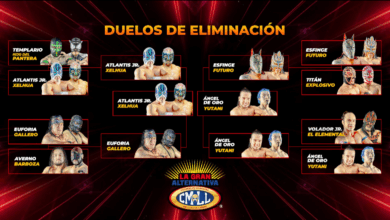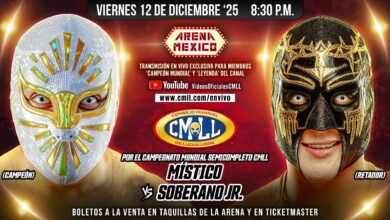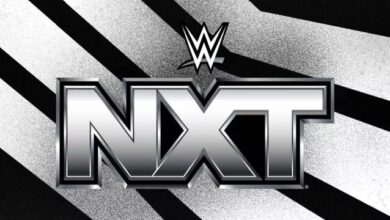Making A Finisher: Stevie Ray’s Slapjack, Harlem Heat’s Heat Seeker

A finishing move in the world of wrestling is crucial. Something that can make or break a pro wrestler, often the coolest looking moves don’t click, while something as goofy as “The People’s Elbow” becomes iconic. Each wrestler has a different method to their madness when landing on their signature, match ending match up. In this new series, “Making A Finisher,” Fightful.com will go in depth with wrestlers as they explain their moves, discuss how they were developed, who took it the best, the worst, why they stopped doing some of them, and the psychology behind them.
***
Stevie Ray carved several paths throughout his wrestling career, and had some help with memorable finishers along the way.
After his time with Harlem Heat, Stevie had his fair share of roles in the wrestling business. Singles wrestler, announcer, trainer, podcast personality — and member of the nWo Black and White. It was during his time in the New World Order that he was given a new gimmick as a slapjack wielding badass who utilized a crippling move that bared the namesake of his weapon. When Stevie talked to Fightful.com, he told us that he was simply handed a slapjack by WCW’s head of security, Doug Dellinger.
“I remember one day, Doug Dellinger giving me a slapjack, and saying, they told me to make this for you. ‘They told me to make this for you.’ I never asked for this. I don’t know if somebody heard it or took it to the office or the writers or whatever. I remember having a conversation … I was at home, looking at an old movie, man. And back in the old movies, like the ’30s and ’40s, these guys would … these gangsters would hit a guy on the head with this thing, you know what I’m saying? And I hadn’t seen that in a long time, since I was a kid, because it’s rare that you see the old movies anymore these days. Old, nowadays, is like the ’80s. Me and a buddy of mine, actually he lived in Indianapolis, he’s a drag racing crew chief, Lee Beard, he’s a good friend of mine. I was telling him about it and he’s like, ‘yeah, man, that’s what they call a slapjack, when you hit a guy on the back of the head’ and blah blah blah. When I went back on the road, I was talking with a group of guys, and I was like man, if I ever had a finish, man, I would like to call it the Slapjack, where I hit somebody on the head. The guys thought it was funny. So I guess somebody was listening to that!,” said Stevie.
Stevie would adopt a finishing move that was made his own. While Triple H had popularized the Pedigree, Stevie Ray looked to make the technique his own.
“I didn’t. I know Triple H kind of jumps back, you know what I’m saying? I just used to pick the guy up and just come down,” Remembers Stevie. Come down, he did. Stevie would often get his opponent vertical before bringing them down, without leaving his feet.
As far as his time with Harlem Heat? “All those moves me and my brother came up with and made up as just, out of conversation and things of that nature,” said Stevie.
Stevie’s partner in Harlem Heat, and real life brother Booker T had plenty of finishing moves to choose from on his own. Harlem Heat was no different, although it was the Heat Seeker most fans remember. The move sees Stevie Ray utilize an Electric Chair on an opponent while his 6-foot-3-inch tall, 256 pound brother came off the top rope with a dropkick — not an easy thing for Booker to take himself. Stevie credits Booker’s creativity, but says they were also looking out for their adversaries.
“Oh man, he liked it. He wouldn’t have done it if he didn’t like it. A lot of that stuff, he comes up with. A lot of it we would come up with together. We see people hit a guy and then flip him back — if you ever notice, a lot of the stuff that we did we were trying to protect the guys. Easy for me to fall back with the guy. People would come up to us and go, ‘why don’t you just flip the guy off your shoulders?’ Well, you know, I was a cautionary type of personality, and I’m like, what if this guy fucking falls back and breaks his neck? I know it looks good, and I know it looks real devastating, but at the end of the day, we’re not going to get a chance to really do these spots when we’re working top guys. Because a top guy, he’s not going to go for that, the way WCW was. Top guy, they’ll have somebody they can go talk to in their office, one of the bookers or agents, and they’ll go ‘no, I don’t want to do that,’ and then they’ll come to us and say, ‘oh, these guys don’t want to do it, let’s change it’ to this that and the other. So all that kind of stuff we only kind of did with middle of the card type guys,” said Stevie.
That style of bump was popularized in the 1980s, often with teams such as the Road Warriors propelling their opponents off of their shoulders backwards, fully rotating and (hopefully) landing face down. This was before the days of the Performance Center, and before that type of bump became the norm. For Harlem Heat, that visual wasn’t too important.
“We could have done that, but it wouldn’t have got us over any more than we already are. Me and my brother, we were trained that way. You don’t have to be reckless to get over. Now if I brought up five other tag teams, I promise you, you’ve heard stuff like that.I’m not going to name any names. But you know what I’m talking about, or who I’m talking about,” Stevie told me.
In fact, when the duo ended up hurting someone, they cut a move from their arsenal. The Harlem Hangover — a move that Booker would later use in his singles run, ended up injuring a foe in the ring. Stevie admitted blame and explained how that went down.
“We had one where I would hit the guy with a side slam, and then my brother would jump off the top rope, do a flip, and hit him with a leg drop. (It) was called the Harlem Hangover,” said Stevie Ray. “And one day he gave a guy an actual real hangover, so we kind of stopped doing it. It was my fault, because I put the guy too close. he further he’s out, as long as my brother’s leg touches him, the spot looks good, you see what I’m saying? But I put him too close, so when Booker did his somersault, he was underneath the guy. He tried to protect him by putting his hands down but he still caught him a little bit, and the guy was really pissed off, man. The guy was a friend of ours too, man, so we kind of looked at each other. We did it a couple more times and it was like well, let’s come up with some more finishers.”
Stevie Ray looks back fondly on his time with Harlem Heat, and the moves that helped establish them. For Stevie and Booker, despite both being huge men, switching it up was integral to their success, so Stevie tells it.
“Our whole thing was about Kobe and Shaq. No lie,” he said. “That was the way we even worked in the ring. I never tried to be a point guard, he never tried to be a center. You know? And we never wanted to do anything similar. Anything. Let me get the rebounds, and you shoot the three pointers. That was the whole deal. Whereas most tag teams, a lot of them … they’re wearing the same thing, you pretty much can’t tell them apart. It’s pretty much the same guy.”
Hear our full conversation with Stevie Ray about Harlem Heat’s finishes, as well as his own, above.
Past editions!
Adam “Hangman” Page’s Dead Eye
Damien Priest’s South Of Heaven Chokeslam
Stevie Ray’s Slapjack, Harlem Heat’s Harlem Hangover
“Switchblade” Jay White’s Blade Runner
Christopher Daniels’ Angel’s Wings
Magnum TA’s Belly-to-Belly Suplex
Darren Young’s Crossface Chickenwing
Kevin Owens’ Stunner and Steenalizer




